Enemies and pests of bees

Moth, or wax moth.
This is the most intrusive pest of honeycombs, and sometimes the brood of bees. There are several types of moths. On our apiaries are seen two of its kind: larger and smaller. Butterflies moths ash-gray, with a roof-shaped folded wings. A small moth and its larvae are quicker than large ones.
In some apiaries where the moth is struggling badly, from spring to autumn you can meet these butterflies flying near the hives. They climb under the covers of the hives, in the cracks, grooves, under the pillows, etc. and they are looking for a convenient moment to get into the nest. This is easier for them to do at night, when the vigilance of bees weakens, as well as in weak and non-starter families. Having climbed into the hive, the moth lays eggs of corpulent color somewhere in the bottom of the hive, among crumbs of wax or other litter, for 7-9 days, or in folds of canvas bedspreads, and sometimes directly into cells of honeycombs. The egg has a length of 0.5 mm. It’s hard to notice even on a dark honeycomb. Development of the egg lasts 8-10 days.

Fig. Wax moth: moth eggs, on the right – in an enlarged form; 2 – the larva; 3 and 5 – the male; 4 – female.
The larvae that emerged from eggs have a length of about 2-3 mm. They sharpen first the waxy debris at the bottom of the hive, but soon they switch to the older honeycombs and begin their destructive work here. They feed on the skin of the bee brood, remaining in the cells after molting the larvae when turning them into a chrysalis, and waxing. Moth larvae are initially white with a brownish dexterity. Subsequently they become dirty gray with a brown head.
To find the food, they sharpen the wax, making the galleries along the mediastinum of the honeycomb and planting the cobwebs protecting the moth larvae from

Fig. A honeycomb struck with a wax moth.
The development of the larva takes about 20-25 days. When the larvae ripen, they begin to pupate. Pupation occurs in the places where the larvae lived (in honeycombs, linen ceilings, in the crevices of the floor, etc. In the cocoon moth is 10-18 days, and all from laying eggs to butterfly leaves from 38 to 53 days (usually 40 -45 days.) At temperatures below 10 degrees Celsius heat creeps into a stupor, which can last for months, until warm days.
At -5 њ C for 1-2 days, the cold kills larvae and butterflies. At 10-15 њ C the eggs die. Measures to combat moth themselves are as follows. Keep hives clean and tidy. To do this, at least once a month to clean the dons and grooves in them.
Honeycombs heavily affected by wax moth, must be removed from the hive and melted to wax. If the larvae of the wax moth are very small, only a few cells are affected, or the brood frames that can not be removed are discarded, then these honeycombs should be carefully cleaned of the wax moth larvae and left in a hive, but continue to observe this family.
Weak families are unable to keep the hive clean and fight the moth. Therefore, it is necessary to conduct this way, care for the bees and their contents, so that only strong families are in the apiary.
Bees of a strong family are able to gnaw honeycombs and throw out pests of the pest.
Hives should be serviceable, since in bad hives moths are comfortable to nest. Slots inside the hive must be sealed with putty, and do not hammer only with slats, under which larvae of moth usually climb.
Spare frames with honeycombs are also damaged by moth. Here you need to be very alert wax moth will destroy all honeycombs. Therefore, special care must be taken to store a spare land.
Keep the spare honeycombs in tightly closed boxes, cabinets, spare hives and extensions, placed on each other without donjev so that there could not penetrate the mole, as well as the mouse. Above, such a column is covered with a grid, a flat roof or a detachable bottom of the hive. Below it, an empty hive shell is placed, covered with a grid, so that the mouse does not get into the column.
But honeycombs with testicles of moths or undetected small larvae can enter these boxes, which later will destroy them. Therefore, to conserve spare cells, they must be fumigated with sulfur, carbon disulphide or formalin vapors. For this purpose, put a metal pan with hot coals in a cabinet with honeycombs and pour pounded sulfur on them – one tablespoon (40-50 g) of sulfur per 1 cubic meter. m of the cabinet volume. To prevent a fire, it is necessary to put the baking tray on the bricks, and also to ensure that it does not touch the frames, honeycombs and wooden parts of the cabinet anywhere. For 1 cu. m volume of the cabinet needs 50 cu. cm formalin or 150 cc. cm carbon disulphide. The door of the cabinet closes tightly, the wintering small crevices are sealed with paper. During the summer fumigate the frame several times.
The moth does not tolerate the smell of turpentine, and therefore once a month you can spray them with frames and all store them. In addition, turpentine on a saucer can be placed on the bottom of the honeycomb repository. The moth does not tolerate drafts, so some beekeepers store spare honeycombs in attics, and when opening windows from opposite sides, they arrange a strong draft. However, in the attics of rooms with iron roofs in summer it is impossible to store honeycombs, since they are from; high temperatures can greatly soften, deform, and sometimes melt.
To moth larvae, in case of their appearance, could not move quickly from the frame to the frame, you need to hang the honeycomb frame 2-3 cm apart.
Do not store honeycombs in the cellars: they are moldy there. Bees do not accept such honeycombs. Unfavorable (old) honeycomb should be drowned as soon as possible on wax.
Sometimes honeycomb is knocked down into dense spheres, or tamped into boxes, but often with such storage the moth still affects wax raw materials.
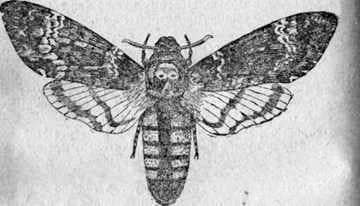
Fig. Butterfly “dead head”.
Mice and shrews.
Mice still fall asleep in the fall and build nests there. During the winter rest of bees, they not only eat honey and gnaw honeycombs but also eat bees, leaving only the end of the abdomen where the stinger is hidden. In addition, they harm by the fact that their presence in the hive or the desire to penetrate it disturb the bees. All the restlessness in the winter and the impure air are extremely harmful to bees. Shrew is a voracious insectivorous animal. It is very similar to a mouse, but it is more dangerous than it is in that, being a very small mammal, it freely climbs through the hive into the hive and produces so much devastation.
The fight against mice consists in the extermination of them with the help of traps, as well as poisoned baits.

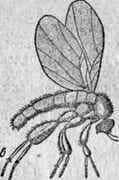
Fig. Hunchback-flies:
A-pupa; c – adult insect (increased).
Ants.
Ants steal honey. If they are few, then they do not do much harm to the bees. If, however, a large number of ants are planted in the apiary, they will intrude on hives to eat honey or build their nest there. The best way to deal with ants is to destroy anthills. To this end, they watered with a solution of salt, or poured with boiling water. You can dust an anthill with DDT dust or pour with kerosene and burn, or dig out the ground and sprinkle it with quicklime. Sometimes on pod stakes arrange catching rings with the use of wheeled ointment and tar so that in the hives there is no bait for the ants, it is necessary to keep the hives in good order and clean and do not spill food anywhere.
Among the insects, the bees are also referred to as bees and beehive beetles, butterflies – “dead heads, pervasive moths, hornbills, and others (but the damage from them in Ukrainian apiaries is usually insignificant).
Predator bees.
Predator bees are some species of birds and insects. Among birds, especially insectivores, there are many who attack bees and eat them. Therefore, in some guides on beekeeping, individual authors describe as an enemy of bees any bird caught by any beekeeper in that she ate a bee. However, every worker of beekeeping should remember well that insectivorous birds are invaluable friends and helpers in combating insects, which cause terrible damage to our forests, fields, orchards and gardens. And therefore, in no case should you chase such birds as the woodpeckers starlings, titmouses, swallows, songbirds, flytraps, nightingales, orioles, wagtails (plisks), krapivians (firehorses), redstarts and. etc., suspected of the fact that they sometimes eat bees.
All these birds grab the bees only at a time when little or no other small insects.
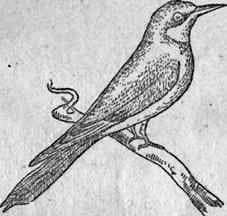
Fig. The bast is golden.
The Golden Bunting is the worst enemy of bees. The most favorite food of the beef is made up of pathetic insects, especially bees. In the south (in the Caucasus, Crimea and other southern regions of Ukraine), where this bird is found, the apiaries suffer greatly from it.
The golden sturgeon has a characteristic, extremely beautiful plumage. Body greenish-blue, neck bright yellow, back of brown-brown color, abdomen greenish and tail bluish-green. Its beak is long, black. These birds dig long holes along the steep banks of rivers and ravines, lay 3-4 eggs there and take out the chicks.
Beefs, like swallows, are excellent flyers. Large flocks of shchukok go for days on apiaries and destroy countless bees that are caught on the fly.
To discourage these birds from the apiary, beekeepers are forced to shoot from rifles, but this does not give significant results. In the same purpose, high staves are hung on the apiary, on which bright flags hang, but this also helps a little. A more effective, albeit much more labor-intensive measure is the ruin of the nests, as well as the poisoning of the stings in them with carbon disulphide, into which the rags soak, quickly put into the burrow with the nest and cover the entrance to the burrow with earth. Do this in the evenings, after the termination of summer birds, in the spring, until the beetles have not yet brought out the chicks.
Shrimps are also enemies of bees. If they settle near apiaries, then a large number of flying bees are exterminated. The damage from shrouds is aggravated by the fact that they eat eggs and chicks of useful insectivorous birds.
The main measure of the struggle with the shrouds is the ruin of their nests.
Bee-eater (osoeed) is a fairly large predatory bird: its body reaches 65 cm in length. It feeds on wasps, bumblebees, and also bees, causing at the same time, quite often, considerable harm to apiaries.
Measures to combat bee-eaters – the ruin of nests and shooting from rifles. Of insects predators of bees are wasps and hornets, beeswolf and dragonflies
Wasps and hornets feed their children with insects. Hornets especially like to eat bees, which are caught on the fly. By the end of the summer, there are other years of extremely many wasps. They boldly climb into the hives behind the honey.
Wasps are very agile, deft and strong, and therefore easily remain the victors in the fight against bees. They are not as sensitive to cold as bees, and fly on such days when bees can neither fly nor guard flights.
Of the control measures can be pointed to the following: the destruction of aspen and cherry nests and queens and the installation in the apiary bottles, half filled with slightly sweetened water or water with wine vinegar. Usually, after a day or two, the bottles are filled with wasps.
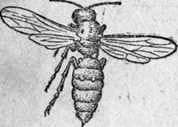
Fig. Hornet.
The bee wolf, or philanthropist, is very similar to a wasp, but differs from a wasp with a large head and yellow belly. It occurs in the middle and southern parts of our country, but especially in large numbers in Central Asia. Nests arrange in mink, which the female digs in dense soil, mainly on slopes.
The female of the bee-eater feeds on honey extracted from the beet’s zobik. Having killed the sting caught by a bee and putting it on its back, it presses on the abdomen. Honey from the zobic protrudes on the tongue of the bee and immediately merges with the female bee-wolf. Having sucked honey, it leaves the bee, if its corpse is not needed for the feeding of the larvae. Otherwise, she carries the corpse to her burrow. There the female lays an egg on the bee’s breast. The larva leaves the egg and eats the bee. Before its maturation, it eats several bees. In the fight against the philanthropists resort to pouring the nests with couples of carbon disulphide, and also use the dust of DDT, laurent, etc. These insects are caught in bottles that are half full, but they do not so willingly climb into bottles like wasps.
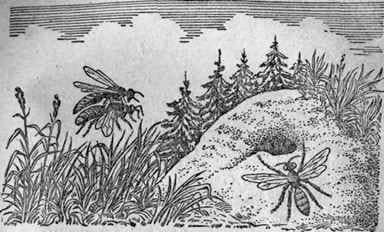
Fig. A bee-wolf with a bee caught and his dwelling.
Dragonflies. They belong to daytime predatory insects. In other years, a large number of dragonflies appear. Then they exterminate many flying bees and flying young queens. A fight was not found.
Enemies and pests of bees
